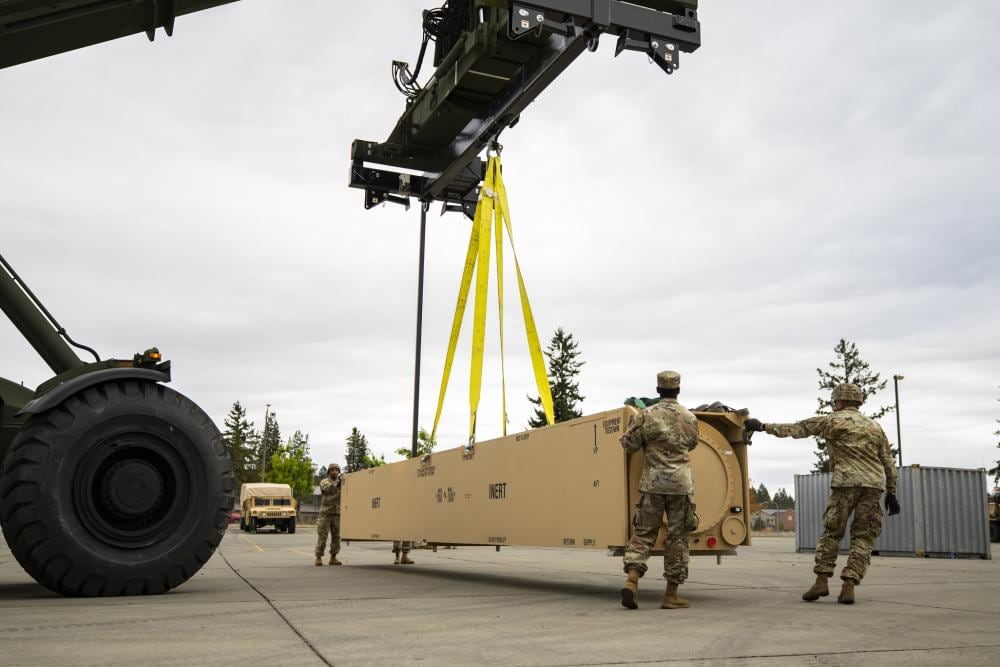WASHINGTON — The U.S. Army has completed its delivery of the first hypersonic weapon capability to a unit two days ahead of deadline, according to service officials from the Rapid Capabilities and Critical Technologies Office. Those officials were on the ground at Joint Base Lewis-McChord in Washington state as the unit unloaded the last of the trucks containing equipment for the battery.
The I Corps’ 5th Battalion, 3rd Field Artillery Regiment, 17th Field Artillery Brigade received the first equipment for the battery in March 2021 — consisting of two training canisters — and wrapped up Sept. 28, Col. Ian Humphrey, the Army’s hypersonic project office’s project manager for integration, told reporters in an Oct. 7 briefing.
“From a blank piece of paper in March 2019, we — along with our industry partners and joint services — delivered this hardware in just over two years. Now, Soldiers can begin training,” Lt. Gen. L. Neil Thurgood, the RCCTO’s director, said in a statement.
The system is called “Dark Eagle,” said Rob Strider, who is in charge of the Army’s hypersonic project office.
The equipment includes a battery operations center, four transporter-erector-launchers, and modified trucks and trailers that make up the ground equipment of the Army’s Long-Range Hypersonic Weapon, or LRHW.
Fielding to the 5-3 FA will be complete in fiscal 2023, Strider said, but would not specify when the all-up hypersonic rounds would be delivered to the unit due to security concerns.
The Army worked with industry to build the industrial base for the hypersonic weapon glide body because the domestic private sector had never built a hypersonic weapon. The service also separately produced launchers, trucks, trailers and the battle operation center necessary to put together the weapon battery.
Lockheed Martin is the weapon system integrator for the Army’s hypersonic capability that will be launched from a mobile truck. Dynetics was chosen to build the hypersonic glide body for the missile. The glide body is being built for use across the armed services, but will be launched from different platforms depending on the branch.
Now that the unit has the necessary equipment, it can begin training for the first joint flight campaign test scheduled with the Navy for the first quarter of FY22. The unit will also prepare for subsequent tests in the fourth quarter of FY22 and the second quarter of FY23.
The 5-3 FA will not participate in the hypersonic flight test scheduled for the first quarter of FY22. That test was supposed to take place in the third quarter for FY23 for nontechnical reasons.
The first test of the Common-Hypersonic Glide Body, or C-HGB, took place in March 2020 when a missile launched from the Pacific Missile Range Facility in Kauai, Hawaii, and hit its target with 6 inches.
Hypersonic weapons are capable of flying faster than Mach 5 — beyond the speed of sound — and can maneuver between varying altitudes and azimuths, making it difficult to detect. The C-HGB is made up of the weapon’s warhead, guidance system, cabling and thermal protection shield.
The U.S. is in a race to field hypersonic weapon capability as well as develop systems to defend against hypersonic missiles. China and Russia are each actively developing and testing hypersonic weapons.
The 5-3 FA, through training and a joint flight campaign, will help the Army develop the doctrine, tactics, techniques and procedures to operate the capability within formations.
But soldiers have been deeply involved in the program since the beginning, with more than 1,000 hours of “soldier-centered design,” Humphrey said, using virtual and augmented reality as the system was built.
“In delivering a prototype, we understand we are not delivering the perfect solution,” Strider said in the media briefing, “and we tailor our acquisition risk acceptance practices accordingly. Our goal is to deliver a prototype that soldiers can use and the mission requires that is deemed safe and that the Army can leverage as a potential baseline for a program of record. Soldier-centered design has been a key part of this effort in reducing risk to ensure an operationally effective weapon system.”
Jen Judson is an award-winning journalist covering land warfare for Defense News. She has also worked for Politico and Inside Defense. She holds a Master of Science degree in journalism from Boston University and a Bachelor of Arts degree from Kenyon College.




